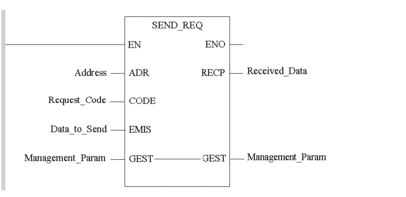Function Description
The SEND_REQ function is used to code and send all
UNI-TE and Modbus/Jbus requests, as well as receive the associated
responses.
Coding details for UNI-TE requests are provided in the reference manual: Communication Reference TSX DR NET.
Details on coding the Modbus/Jbus requests are provided in the TSX DG MDB manual.
Modbus requests common to all Schneider devices are presented in Architecture and Communication Services.
The additional parameters EN and ENO can be configured.
FBD Representation

LD Representation

IL Representation
LD AddressSEND_REQ Request_Code, Data_to_Send, Management_Param, Received_DataST Representation
SEND_REQ(Address, Request_Code, Data_to_Send, Management_Param, Received_Data);Parameter Description
The following table describes the input parameters:
Parameter |
Type |
Comment |
|---|---|---|
|
ARRAY [0.. 5] OF |
Address of the destination entity of the exchange. The type of address depends on the request sent. It is therefore possible, for example, to broadcast the RUN request (ALL, 0 for the TSX SCY 11601 module) whereas it is impossible to send an identification request to several devices simultaneously. |
|
|
Request to be sent to the destination device, also called server. Requests may be UNI-TE requests or Modbus requests. |
|
ARRAY [n... m] OF |
Integer table to be sent to the destination device of the request. This table depends on the request sent. It must have a minimum length of 1 element, even if the request used does not require data to be sent (for example an identification request). Note: It is imperative that the length of the data to be sent (in bytes) be assigned to the fourth word of the management table before launching the function, in order for this to be correctly executed. |
The following table describes the input/output parameters:
Parameter |
Type |
Comment |
|---|---|---|
|
ARRAY [0.. 3] OF |
The following table describes the output parameters:
Parameter |
Type |
Comment |
|---|---|---|
|
ARRAY [n... m] OF |
Integer table containing the data
returned by the server device which was the destination of
the request. Although certain requests do not require a response (for
example a Run request), it is nevertheless necessary to reserve a
minimum table of 1 integer each time the Note: The size of the data received is written automatically by the system in the fourth word of the management table. Note: In certain cases (reading of word tables for example) it is necessary to resequence the objects received by using the ROR1_ARB function (shift of a byte in a table). |
Simultaneous Transactions
The following table gives the capacities of each communication
channel to simultaneously process transactions according to various
configurations on Micro and Premium PLCs. (SEND_REQ is not available for Modicon M340/M580 and for Modicon Quantum PLCs.)
Configuration |
Micro |
TSX 57 10 |
TSX 57 20 |
TSX 57 23/30/40/45/55, PCX 57, PMX 57 |
TSX 57 46/56 |
|---|---|---|---|---|---|
Uni-Telway master terminal port |
4 |
4 |
4 |
4 |
8 |
Uni-Telway master PCMCIA or SCY link |
1 |
8 |
8 |
8 |
8 |
Uni-Telway client slave terminal port |
4 |
1 |
1 |
1 |
8 |
Uni-Telway client slave PCMCIA or SCY link |
1 |
1 |
1 |
1 |
1 |
Uni-Telway server slave terminal port |
4 |
4 |
4 |
4 |
4 |
Uni-Telway server slave PCMCIA or SCY link |
4 |
6 |
6 |
6 |
6 |
Modbus terminal port |
4 |
- |
- |
- |
- |
Modbus PCMCIA or SCY link |
4 |
8 |
8 |
8 |
8 |
Character mode terminal block |
1 |
1 |
1 |
1 |
1 |
Character mode PCMCIA or SCY link |
4 |
8 |
8 |
8 |
8 |
CANopen PCMCIA |
- |
10 |
10 |
10 |
10 |
Fipway PCMCIA or SCY link |
4 |
8 |
8 |
8 |
8 |
Modbus Plus |
4 |
4 |
4 |
4 |
4 |
Ethernet |
- |
16 |
16 |
16 |
16 |
Embedded Ethernet |
- |
- |
- |
- |
64 |


